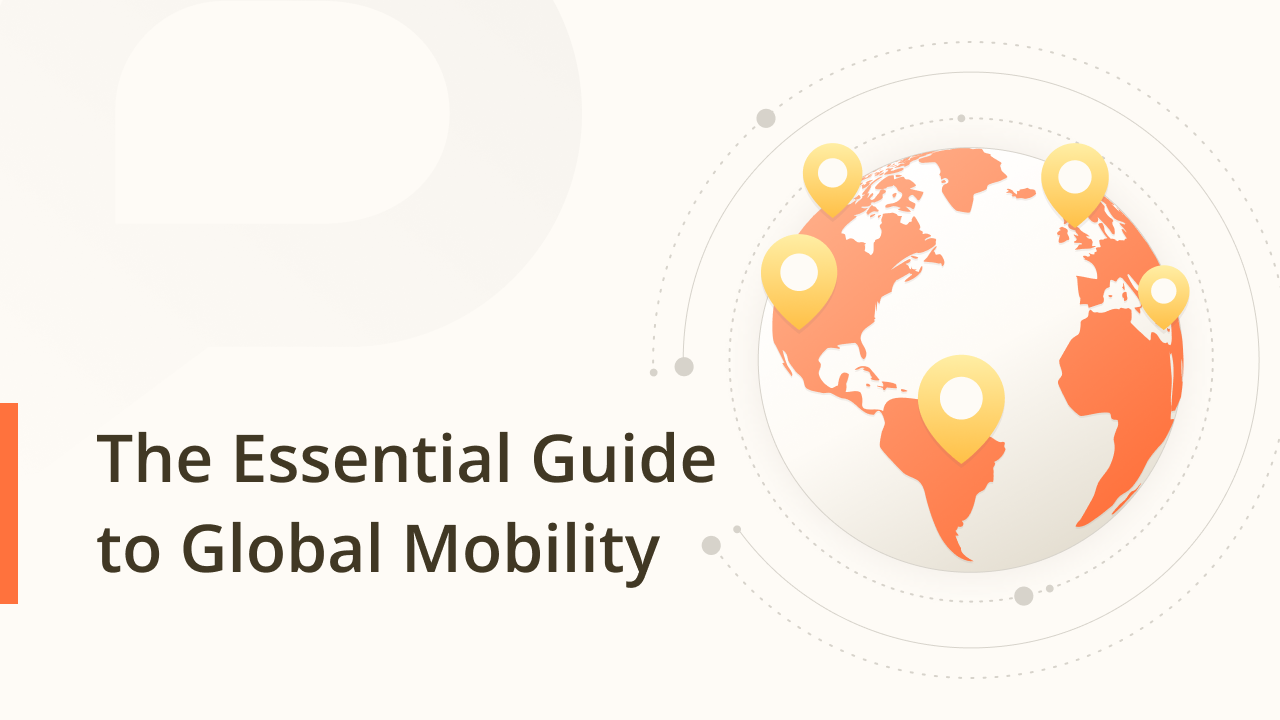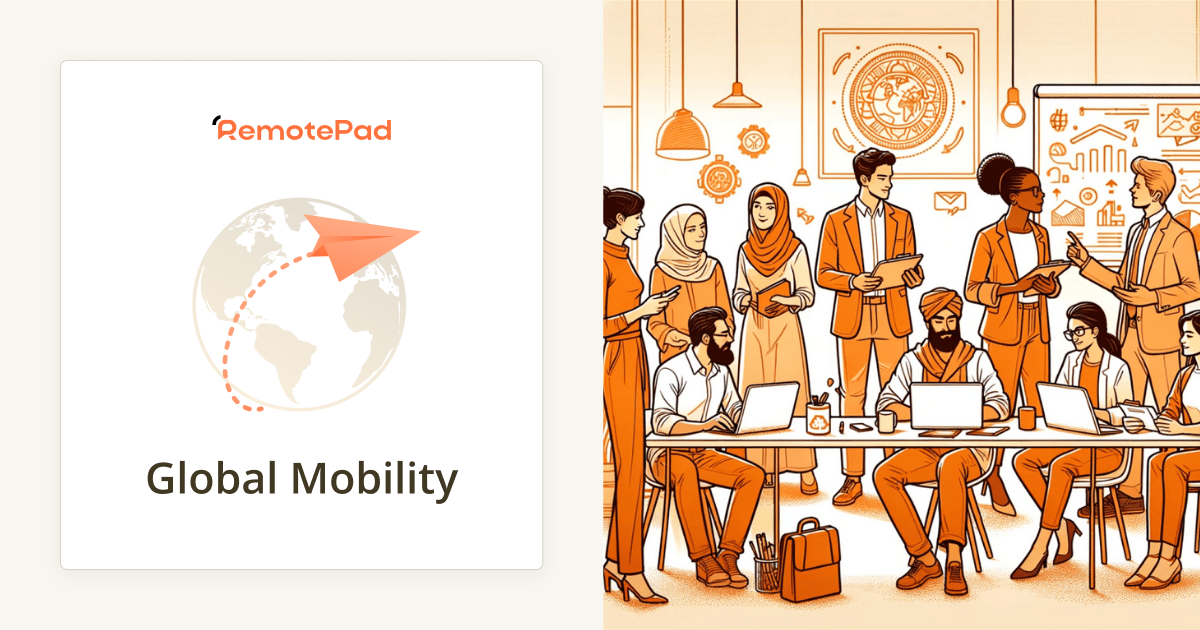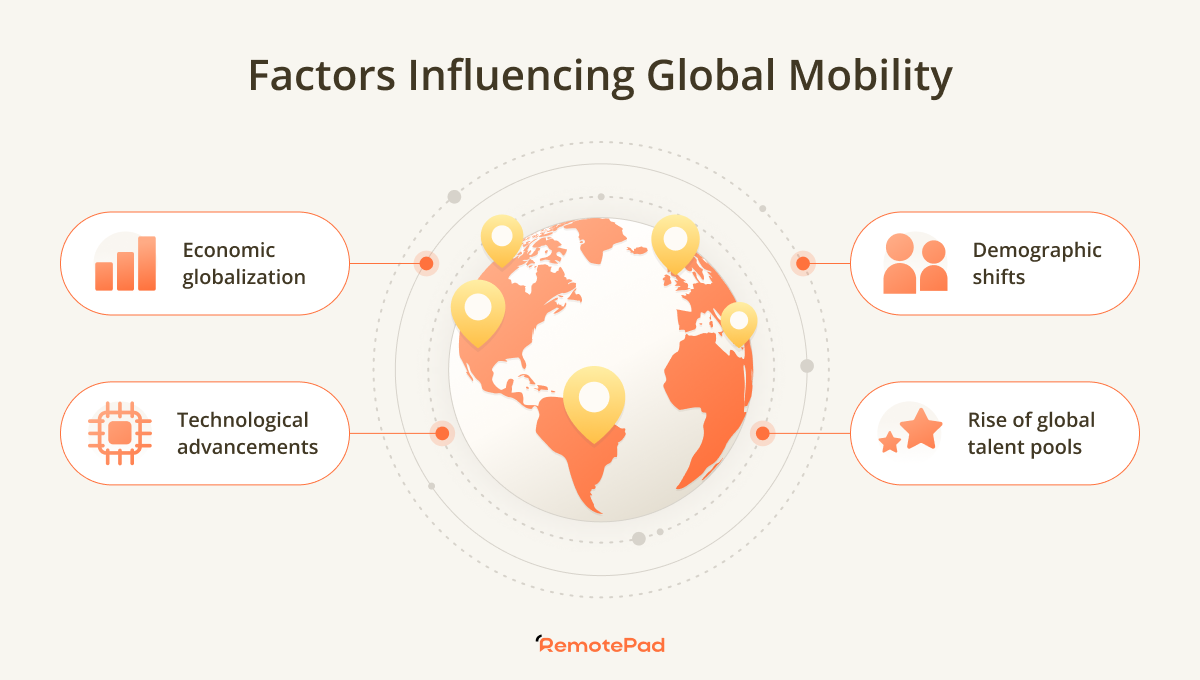Table of Contents
showSpending too much on recruitment, payroll or global HR?
We help you find the Best Providers at the lowest cost.
Global mobility refers to the capacity of a company to relocate employees to different countries for work, encompassing logistical, legal, and HR aspects to facilitate international assignments and transfers.
Key Takeaways
- Global mobility has a range of benefits for companies, including employee retention, building skills, and tapping into new international markets.
- Global mobility also presents challenges, such as managing the process can be expensive, and it is difficult to guarantee compliance.
- To ensure compliance, we recommend thinking carefully about the benefits of outsourcing global mobility management and engaging a third party to manage the process.
Imagine expanding your business internationally, tapping into diverse talent pools, and quickly accessing new markets. This may sound like a dream, but it’s possible with a thorough global mobility strategy. Managing a global workforce is more critical than ever in today’s interconnected world. Are you ready to unlock the mystery of worldwide mobility and embark on a journey toward seamless international business operations? Let’s dive in!
What is Global Mobility?
Global mobility means managing a company’s international employee population, including relocation, remote work, and compliance with relevant laws and regulations, which is fascinating. It plays a crucial role in business expansion, allowing companies to access new markets and a variety of talent and fostering innovation through a thorough global mobility strategy. However, implementing an effective global mobility program has challenges, such as immigration, compliance, and cultural acclimation in a foreign country.
An effective global mobility program consists of various components that ensure smooth employee transitions and compliance with international regulations. The subsequent sections provide an overview of these components and steps to formulate a robust strategy, surmount challenges, and effectively utilize global mobility solutions.
Global Mobility Definition
Global mobility refers to a company’s capacity to transfer its personnel across borders, ensuring adherence to local laws, immigration, and taxation regulations. It’s an essential element of international expansion, specifically the movement of employees across borders to support the company’s global operations.
Focusing on compliance allows businesses to evade penalties and reduce risks tied to non-compliance in their global mobility initiatives.
Factors influencing global mobility
Several factors are fueling the trends around global mobility.
These are among the top ones:
| Factor | Description | Impact on global mobility |
| Economic globalization | Increased trade, investment, and labor mobility across borders | Expanding opportunities for employment and career advancement in different countries |
| Technological advancements | Development of communication tools, remote work platforms, and global collaboration platforms | Facilitating remote work and enabling individuals to connect with opportunities worldwide |
| Demographic shifts | Aging populations in developed countries and growing young populations in developing nations | Creating a demand for skilled labor and fostering international migration patterns |
| Rise of global talent pools | Availability of skilled professionals in various fields across the globe | Encouraging companies and organizations to tap into these talent pools for international expansion |
Importance of Global Mobility
The significance of global mobility goes beyond just the physical relocation of employees. It enables businesses to access new markets, a variety of talent, and potential for growth and innovation. Businesses can significantly widen their talent pool by harnessing global mobility and allowing personnel to work remotely, thereby enhancing the probability of acquiring the perfect individuals for roles, irrespective of their geographical location.
Moreover, global mobility can bolster talent retention by offering employees the chance to travel and work abroad and providing flexible work arrangements. This benefits the employees and contributes to the company’s competitive advantage in attracting and retaining high-caliber personnel.
Video: What Is Global Mobility?
What Are the Benefits of Global Mobility?
A business that implements a global mobility program will have clear advantages over its competitors, including:
1. Increased Workplace Productivity
When organizations promote global mobility, employees feel their growth aspirations are recognized. This, in turn, helps to maintain your employee retention rate and maintain employee engagement and productivity.
2. Enhanced Employee Skillsets
Many businesses across the globe are failing to operate to their full potential due to skill shortages. Relocating talent from overseas countries is one effective short-term solution for this issue. Not only does the business benefit from that but so does the employee who can develop their career skills.
3. It Allows You to Tap into New Markets
Global mobility allows your business to explore new markets abroad. Through global mobility, a business can place experienced staff overseas to oversee operations and quickly build a market-dominating presence there. Along with the intrinsic benefits of a new consumer market, this kind of international expansion diversifies revenue globally and increases business stability and resilience.
Key Components of an Effective Global Mobility Program
An effective global mobility program requires various components to ensure seamless employee transitions and adherence to international regulations. These components include compliance management, employee support services, performance metrics, and analytics. Businesses can craft a successful global mobility program congruent with their overarching objectives and expansion plans upon addressing these components.
Subsequent subsections offer a deeper examination of the key components of an effective global mobility program, along with insights into optimal practices for managing each facet.
Compliance Management
Compliance management is an integral part of any global mobility program. It ensures adherence to local laws, immigration requirements, and tax regulations for each country where employees are based. This includes understanding and managing obligations such as shadow payroll and accurately calculating and reporting the applicable tax liabilities for international employees to their host countries while still paying them from their home country’s payroll.
Legal teams play a crucial role in compliance management, as they provide advice concerning home taxes while an employee is abroad and coordinate with experts in foreign tax and immigration legislation. Maintaining awareness and collaborating with legal teams and third-party experts enable businesses to surmount the complexities of legal and tax compliance in their global mobility initiatives.
Employee Support Services
Employee support services are essential for ensuring a smooth relocation process and successful integration of international employees into their new environment. These services encompass assistance with relocation, cultural adaptation, and continual support for international assignees.
Designing a compensation structure for global mobility ensures transparency and fairness for employees relocating to a new country. Companies can also support employees culturally adapting to a new country by implementing the following:
Cross-cultural policies
Resolving cultural conflicts
Cultivating a safe and inclusive environment
Providing language and cultural training
Offering support for families during relocation
This support facilitates employees’ transition and fosters talent development and retention.
Performance Metrics and Analytics
Performance metrics and analytics are essential for assessing the success of a global mobility program and informing decisions for improvement. Data collection in global mobility programs involves gathering and analyzing data from various sources, such as:
Employee records
HR systems
Vendor databases
External data providers
Data analytics and technology are crucial for processing and interpreting the collected data, allowing organizations to gain insights, identify trends, and make data-driven decisions in managing their global workforce. Using performance metrics and analytics enables businesses to boost the efficiency of their global mobility program and make educated decisions for continuous enhancement.
Building a Robust Global Mobility Strategy
Constructing an effective global mobility strategy necessitates aligning the program with corporate objectives, engaging pertinent stakeholders, and adapting to changing requirements. A robust global mobility strategy ensures that the program bolsters the organization’s overall aims and expansion plans while effectively addressing the challenges of managing a global workforce.
The ensuing subsections will examine the process of formulating a robust global mobility strategy focusing on aligning the program with business goals, engaging key stakeholders, and adapting to evolving needs.
Aligning with Business Goals
Ensuring the global mobility strategy is aligned with business goals guarantees that the program bolsters the organization’s overall aims and expansion plans. This can be achieved by:
Developing a comprehensive global mobility policy that outlines the company’s objectives and goals
Establishing a global mobility team to ensure the program is effectively managed and monitored
Utilizing technology to track and measure the success of the program
Aligning the global mobility strategy with business goals allows businesses to ascertain that their international workforce management bolsters their growth plans and enhances their overall competitive edge.
Involving Key Stakeholders
Involving key stakeholders, such as HR professionals and legal and finance teams, ensures a comprehensive and well-rounded approach to global mobility management. HR plays a pivotal role in global mobility management, which involves managing and supporting the movement of employees across international locations, developing global mobility policies, facilitating international recruitment and hiring, managing employee benefits and payroll, and providing support and training for employees during their transition to a new location.
Incorporating the expertise of key stakeholders enables businesses to adeptly address the legal, financial, and cultural facets of global mobility, guaranteeing successful and compliant international workforce management in international markets.
Adapting to Evolving Needs
Adapting to evolving needs entails consistently assessing and modifying the global mobility strategy to take into account alterations in the business environment, employee inclinations, and regulatory framework. This includes staying informed about economic trends, social changes, political developments, technological advancements, and environmental factors.
It’s vital to regularly update the global mobility strategy to accurately reflect the current international environment and meet the evolving needs of the business and its employees. By adapting to evolving needs, businesses can effectively manage their global workforce and maintain a competitive edge in the ever-changing global landscape.
How Do I Ensure Global Mobility Compliance?
For growing companies looking to ensure global mobility compliance and reduce risk exposure, the challenge can often be finding a cost-effective way to meet legal requirements. There are several risk areas that organizations should focus on to stay global mobility compliant.
1. Implement a Global Mobility Strategy
A global mobility strategy is a plan formed by your company to correctly and securely transition employees who relocate to or live in foreign countries. By forming and defining your global mobility strategy, you offer legal guidance and support for cross-border employee mobilization. A fully functioning global mobility strategy will be closely aligned with your core business plan, company values, and overall company vision.
2. Comply with Payroll Rules
Utilizing global mobility means ensuring full compliance with laws and regulations relating to your global payroll. To ensure full compliance, you may seek professional advice from a Global Mobility Manager about the payroll-related aspects of global mobility. This includes withholding employee taxes, payroll taxes, and social security (such as National Insurance contributions) from home and destination countries.
3. Hold Necessary Visas and Work Permits
Every country you plan to do business in will have different immigration laws and legislation. Perhaps with the help of a global mobility consulting team, your human resources team needs to compile a list of the necessary work and residence permits for the countries you plan to relocate or hire new employees in:
For example, there are multiple categories of work visas in Poland, whereas Dubai and Qatar only have one work permit category for most employees. At this point, you can determine which aspects of the process you need to deal with yourself, which the employee can deal with, and which might be outsourced to an international HR partner, such as a global Employer of Record.
4. Consider Tax Implications
To avoid problems, you’ll need to understand the relocation tax and employment obligations of both the home and the host country. Figuring this out ahead of time is the best choice because some countries have more complex tax requirements than others, making it difficult for employees to relocate and legally work there.
Shadow payroll is a popular solution to this problem, as it involves keeping employees on the same benefits and insurance within their home country while temporarily relocating them. This is a great option for employees who are working longer in a new country.
What Are the Key Challenges of Global Mobility?
Working with an international team has its challenges. Therefore, a thorough global mobility strategy is essential for modern-day businesses working internationally. Dealing with the ins and outs of immigration, taxes, employee benefits, and other HR compliance topics becomes much more complicated and harder to manage when it is transferred to a global scale. We’ll cover both the challenges of global mobility and how you can overcome them.
1. Visa and Relocation Complications
Relocating an employee involves obtaining the necessary work visa and permit. Many countries, such as China or Japan, have strict work visa requirements, therefore it’s important to ensure your employees have enough time to apply for and obtain their work visa before they are required to start working. Every country has its own set of immigration policies and of course, some are more complex than others, therefore your company needs to be prepared for difficulties and delays.
2. Employee Retention
While we mentioned that global mobility can help with employee relocation, it is a double-edged sword. Relocating is a stressful experience even within the same country; therefore, moving across the globe is a different ball game. It’s up to the HR team to ensure this smooth process throughout.
If your policies don’t work or run smoothly, you may send someone abroad only to have them leave the company once they’ve arrived. Your company’s global mobility strategy should also involve helping employees settle into their new location.
3. It Can Be Expensive
Expanding your business is an expensive process, especially when it comes to relocating your employees. As an employer, it’s common and often expected to offer relocation packages to your employees to cover living cost differences, currency exchange rates, and even often a pay rise as part of the offer. A 2018 study by Wakefield found that most professionals in the US (91%) and the UK (87%) would expect their employer to help with their relocation. Their main expectations include expenses, housing assistance, insurance coordination, and spouse and family support.
Who’s In Charge of Global Mobility in your Workplace?
As we mentioned, relying on your existing HR team to deal with your end-to-end global mobility process and strategy is unproductive. This is why hiring capable global mobility experts is important to ensure your process runs smoothly and securely. Options include:
1. An In-House Global Mobility Manager
Hiring an in-house Global Mobility Manager (GMM) may be a good option. Note that this will usually only be cost-effective when you are implementing global mobility at scale and need a full-time employee resource on the issue.
2. An External Global Mobility Team
Depending on the size of your company and expansion plan, it might be more beneficial to contract external support for complex cases. As mentioned, international hiring and workforce management are complex. Each country has its own particular regulations concerning things like labor compliance and tax law. Realistically, one person alone can’t navigate the bureaucracy of multiple countries.
3. Your Internal Human Resource Team
For smaller companies, neither in-house global mobility management nor external providers may be affordable. In this case, your internal human resource team may be your only realistic option. Given the complexity of international global mobility regulations, if your company decides to do this, we highly recommend investing in thorough training for your existing employees.
Leveraging Global Mobility Solutions
Global mobility solutions are specialized tools and services that assist businesses in managing their international workforce. These solutions provide a streamlined approach to compliance, employee support services, and performance metrics and analytics. By leveraging global mobility services, businesses can overcome the challenges associated with international workforce management and ensure the success of their global mobility program.
The subsequent subsections discuss the various global mobility solutions at businesses’ disposal, including global payroll solutions, employer of record services, and global mobility consultants.
Global Payroll Solutions
Global payroll solutions offer a range of features and benefits, ensuring accurate and timely payments, compliance with local regulations, cost savings, and streamlined payroll processes. Utilizing global payroll solutions for international employee management enables businesses to streamline payroll management, curtail costs, and ensure compliance with local tax and reporting requirements.
Popular global payroll solutions
Deel
Remote
Gusto
Papaya Global
Rippling
These platforms offer a variety of features, such as wage calculation, tax withholding, expense management, process automation, compliance, cost efficiency, accuracy and security, and scalability.
Employer of Record Services
Employer of record (EOR) services allow businesses to:
Hire and manage international employees without setting up a local entity
Reduce the complexity and cost of global expansion
Facilitate global expansion
Provide support to mobile employees
Reduce potential risks associated with employment, taxation, and immigration regulations in different countries.
Employer of record services offers comprehensive support throughout the international expansion process, including:
Recruitment
Onboarding
Global Payroll
Ongoing HR support
This streamlines the process of hiring international employees and ensures compliance with local laws and regulations.
Global Mobility Consultants
A global mobility consultant provides expert advice and support for businesses navigating the complexities of international workforce management. They offer counsel on:
Legal and tax compliance
Cultural transition
Cost optimization
Global payroll solutions
Employer of record services
And more
Harnessing the expertise of global mobility consultants allows businesses to:
Devise and implement effective global mobility strategies
Tackle the challenges inherent in managing an international workforce
Ensure the success of a company’s global mobility program
Support its overall business objectives
This expertise can be invaluable in achieving these goals.
Implement Global Mobility the Right Way
Global mobility presents major benefits for ambitious companies — it means simplifying moving staff around your international locations. However, it also comes with serious compliance challenges: You cannot risk tax, payroll, or immigration non-compliance.
To fully leverage the benefits of global mobility, we recommend implementing a robust global mobility strategy and ensuring you have the right external support to implement it effectively.
FAQ
Global mobility refers to the ability of a multinational workforce to operate and move from one country to another.
Global mobility management (GMM) is a business procedure that manages the end-to-end process for relocation of an existing or new employee.
Global mobility is the practice of sending employees abroad for short-term assignments, long-term assignments or permanent relocation. It's often used by companies to train local staff in a particular skill or practice.
Global mobility is key to maximizing the potential of a workforce and ensuring that the right people are in the right job, delivering the highest standards of customer satisfaction.
HR plays a pivotal role in executing the global mobility strategy, providing key input on employee-related processes and ensuring compliance with paying taxes across countries.




